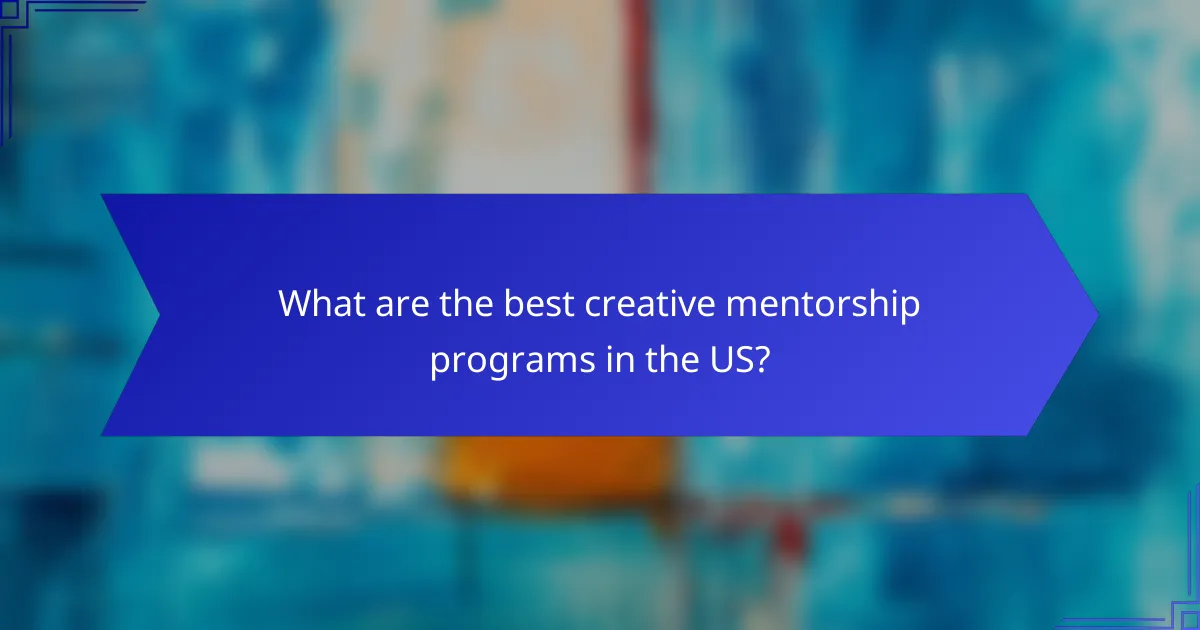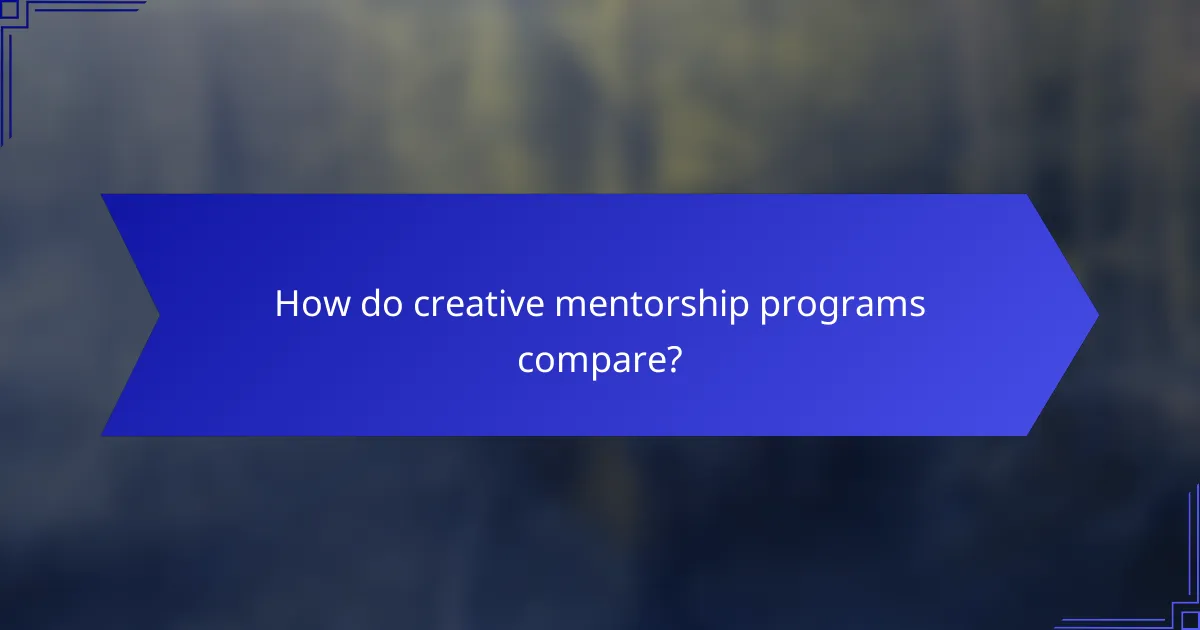Creative mentorship programs play a crucial role in nurturing talent by providing structured guidance, networking opportunities, and skill development tailored to aspiring creatives. To select the right program, it’s important to evaluate key factors such as the program’s objectives, mentor qualifications, and feedback from previous participants. Understanding these criteria will help you make an informed decision that aligns with your personal goals and needs.

What are the best creative mentorship programs in the US?
The best creative mentorship programs in the US offer structured guidance, networking opportunities, and skill development tailored to aspiring creatives. These programs vary in focus, structure, and accessibility, making it essential to choose one that aligns with your specific goals and needs.
Creative Mornings
Creative Mornings is a global breakfast lecture series that fosters community among creatives. Each month, local chapters host talks featuring speakers from various creative fields, providing insights and inspiration.
Participants can engage with peers and mentors in an informal setting, making it an excellent opportunity for networking. To get the most out of Creative Mornings, attend regularly and actively participate in discussions.
Mentor Collective
Mentor Collective connects students and early-career creatives with experienced mentors in their field. This program focuses on personalized mentorship, allowing participants to receive tailored advice and support.
To join, you typically need to apply through your educational institution or organization. Be prepared to set clear goals for what you want to achieve through mentorship to maximize the experience.
ArtStart
ArtStart is a mentorship program dedicated to supporting young artists and creatives through hands-on projects and professional development. Participants work closely with mentors to develop their artistic skills and gain real-world experience.
Consider applying if you are looking for a program that emphasizes practical experience alongside mentorship. Be proactive in seeking feedback and utilizing the resources available to enhance your artistic journey.

How to choose a creative mentorship program?
Choosing a creative mentorship program involves evaluating several key factors to ensure it aligns with your goals and needs. Focus on the program’s objectives, the qualifications of the mentors, and the feedback from past participants to make an informed decision.
Assess program goals
Start by identifying what you want to achieve through the mentorship program. Different programs may focus on various aspects of creativity, such as skill development, networking, or project guidance. Ensure the program’s goals align with your personal or professional aspirations.
Look for programs that clearly outline their objectives and the outcomes they aim to deliver. This clarity will help you gauge whether the program can meet your expectations and provide the support you need.
Evaluate mentor qualifications
The qualifications of the mentors are crucial in determining the program’s effectiveness. Research their backgrounds, including their experience in the creative field, teaching abilities, and past mentorship roles. A mentor with a strong portfolio and relevant experience can offer valuable insights and guidance.
Consider the mentor’s approach to creativity and whether it resonates with your style. A good fit can enhance your learning experience and foster a more productive mentorship relationship.
Consider participant feedback
Feedback from previous participants can provide valuable insights into the program’s strengths and weaknesses. Look for testimonials or reviews that highlight specific aspects of the mentorship experience, such as mentor engagement, program structure, and overall satisfaction.
Pay attention to both positive and negative feedback to get a balanced view. This information can help you identify potential pitfalls and advantages, allowing you to choose a program that best suits your needs.

What are the key criteria for evaluating mentorship programs?
When evaluating mentorship programs, key criteria include program structure, mentorship duration, and cost and funding options. These factors significantly influence the effectiveness and accessibility of the mentorship experience.
Program structure
The program structure refers to how the mentorship is organized, including the format, frequency of meetings, and the types of activities involved. Effective programs often combine one-on-one sessions with group workshops to foster collaboration and learning.
Consider whether the program is flexible enough to accommodate different learning styles and schedules. A structured approach with clear goals and milestones can enhance the mentorship experience, ensuring that both mentors and mentees stay engaged and focused.
Mentorship duration
Mentorship duration is the length of time that the mentorship relationship lasts, which can range from a few weeks to several months or even years. Short-term programs may focus on specific skills or projects, while long-term mentorships can provide deeper insights and ongoing support.
When evaluating duration, think about your personal goals and how much time you can commit. A longer mentorship may offer more comprehensive development, but shorter programs can be beneficial for targeted learning.
Cost and funding options
Cost and funding options are crucial when assessing mentorship programs, as they can vary widely. Some programs may charge fees, while others are free or offer scholarships to participants. Understanding the financial commitment involved is essential for making an informed decision.
Look for programs that provide transparent pricing and explore potential funding sources such as grants or sponsorships. This can help alleviate financial barriers and make mentorship more accessible to a broader audience.

What insights can be gained from creative mentorship program reviews?
Creative mentorship program reviews provide valuable insights into the effectiveness of these programs, highlighting both successes and areas for improvement. Participants often share their experiences, which can guide future applicants and program organizers in enhancing the mentorship experience.
Success stories
Success stories from creative mentorship programs often showcase transformative experiences for participants. Many mentees report significant growth in their skills, increased confidence, and successful project completions that may lead to job offers or collaborations. For instance, a graphic designer might credit their mentor for helping them land a high-profile client after refining their portfolio.
These narratives often emphasize the importance of a good mentor-mentee match, where shared interests and compatible working styles lead to fruitful outcomes. Programs that facilitate networking opportunities tend to produce more success stories, as connections made during mentorship can extend beyond the program itself.
Common challenges
Despite the benefits, common challenges in creative mentorship programs can hinder the experience. Mentees may struggle with unclear expectations or lack of communication from their mentors, which can lead to frustration. Additionally, mismatched skill levels or personalities can create barriers to effective collaboration.
Another challenge is the time commitment required from both mentors and mentees. Busy schedules can limit the frequency and quality of interactions, impacting the overall effectiveness of the mentorship. Addressing these challenges early on can enhance the program’s success.
Participant satisfaction
Participant satisfaction in creative mentorship programs is often gauged through feedback surveys and testimonials. Many participants express high satisfaction levels when they feel supported and valued by their mentors. Programs that regularly solicit feedback and make adjustments based on participant input tend to see higher satisfaction rates.
However, satisfaction can vary widely depending on individual experiences. Factors such as the quality of mentorship, the relevance of the skills taught, and the overall structure of the program play crucial roles. Programs that prioritize ongoing communication and adaptability often achieve better outcomes for their participants.

How do creative mentorship programs compare?
Creative mentorship programs vary significantly in their structure, effectiveness, and the opportunities they provide. Understanding these differences can help individuals choose the right program to enhance their skills and networks.
Program effectiveness
Program effectiveness can be assessed by looking at participant outcomes, such as skill improvement and career advancement. Many programs utilize feedback surveys and success stories to measure their impact, often reporting that participants see tangible benefits within a few months.
When evaluating effectiveness, consider the program’s curriculum, the expertise of mentors, and the resources available. Programs that offer hands-on projects or real-world applications tend to yield better results than those focused solely on theoretical knowledge.
Mentor engagement
Mentor engagement is crucial for a successful mentorship experience. Programs that facilitate regular communication, such as weekly check-ins or feedback sessions, often foster stronger relationships between mentors and mentees.
Look for programs that prioritize mentor availability and responsiveness. High engagement levels can lead to more personalized guidance and support, which can significantly enhance the learning experience.
Networking opportunities
Networking opportunities are a key component of creative mentorship programs, allowing participants to connect with industry professionals and peers. Programs that include events, workshops, or online forums often provide valuable chances to build relationships.
Consider programs that actively promote networking through structured events or collaborative projects. Engaging with a broader community can open doors to job opportunities and collaborations that may not be accessible otherwise.